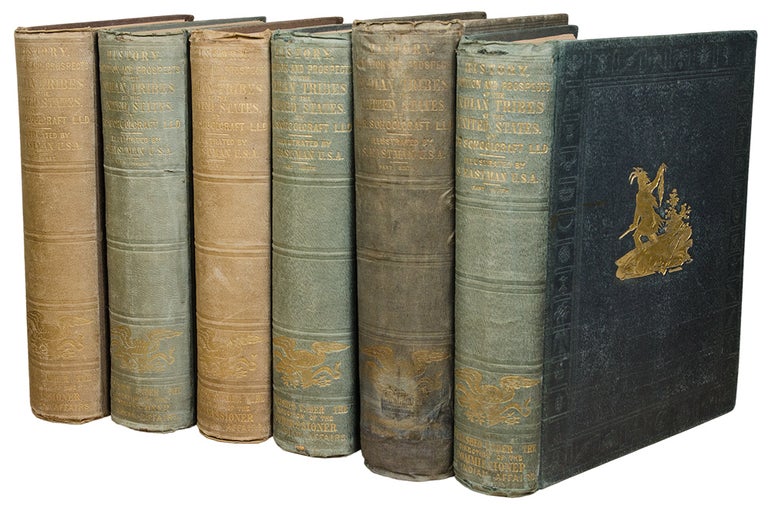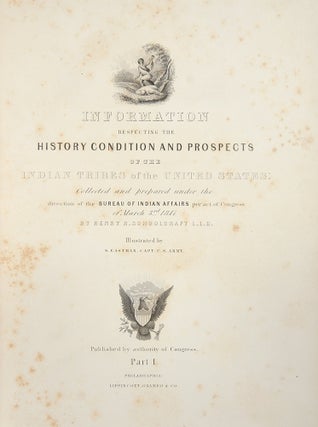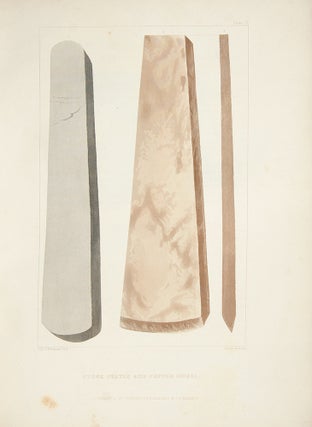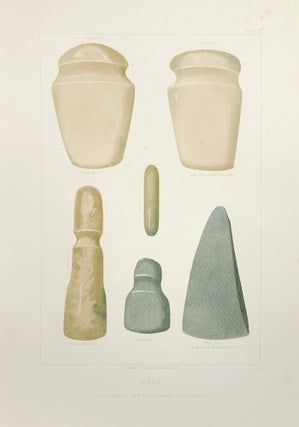SCHOOLCRAFT, Henry Rowe (1793-1864)
Information, respecting the History, Conditions and Prospects of the Indian Tribes of the United States: Collected and Prepared under the Direction of the Bureau of Indian Affairs
Philadelphia: Lippincott, Gambo & Co. [vols. 1-4] or J.B. Lippincott & Co. [vols. 5 and 6], 1853-1852-1853-1854-1855-1857. 6 volumes, quarto. (12 3/4 x 9 3/4 inches). Half-titles. 5 steel-engraved additional titles (additional title to vol.VI not issued), 1 steel-engraved portrait of Schoolcraft to front vol.VI, 1 folding letterpress table, 329 engraved or lithographed plates, plans and maps (i.e 331 plates on 329 sheets) after Seth Eastman and others (some colored).
Publisher's uniform purple (vols. 1 and 3), green (vol. 2) or blue (vols. 4-6) cloth, covers with borders decoratively stamped in blind and a central image of an Indian in gilt, flat spines divided into compartments in blind, lettered in the first compartment and with the seal of the U.S. in gilt in the lower compartment
Provenance: Captain Amiel Weeks Whipple (presentation inscription to Whipple in vols. 1-5 by Schoolcraft [vols. 1-3], Charles Nix [vol. 4] and George Manypenny [vol. 5])
A presentation set of Henry Schoolcraft's masterpiece inscribed by the author to a noted western explorer and Captain of the Corps of Engineers, with manuscript corrections. This work is the most extensive work on Native Americans published in the 19th-century containing "a vast mass of really valuable information" (Field), and a cornerstone of any collection of ethnological studies on America.
Born near Albany, N.Y., Schoolcraft took part in a number of important early surveying expeditions before being appointed commissioner of Indian Affairs in 1822. With his headquarters at Sault Sainte Marie, he married the half-Ojibwa daughter of a local fur-trader, learnt the Ojibwa language and began his ethnographical researches in earnest. He retained his position for almost twenty years and made full use of the unequalled opportunites it provided him. A change in government in 1841 resulted in him losing his position and moving back to the East, but he continued his Native American studies and the first volume of the present work was published in 1851. The work was completed with the publication of the sixth volume in 1857. Field notes that the work as a whole "contains a vast mass of really valuable material. It has indeed performed a very important service for Indian history, in collecting and preserving an immense amount of historic data. Vocabularies of Indian languages, grammatical analyses, legends of various tribes, biographies of chiefs and warriors, narratives of captivities, histories of Indian wars, emigrations, and theories of their origin, are all related and blended in an extraordinary.... manner". The other aspect of the work that gives it immense additional value is the large body of art work by Seth Eastman (1808-1875). Eastman, a serving officer in the U.S. Army, had trained as a topographical artist: a discipline which necessitated a rigourous almost photographic approach to the subject and is ideally suited to the task of recording landscape, objects and individuals as accurately as possible. His work as a whole has ensured that he is now viewed as the foremost pictorial historian of Native American history and culture. The vast majority of the plates in the present work are either from his original drawings or from copies by him of others work. "A very large number of beautiful steel engravings, representative of some phase of Indian life and customs, are contained in the work, but the most valuable of its illustrations are the drawings of weapons, domestic utensils, instruments of gaming and amusement, sorcery and medicine, objects of worship, their sculpture, paintings, and fortifications, pictograph writing, dwellings, and every form of antiquities" (Field). This set with important provenance to Captain Amiel Weeks Whipple (1818-1863). During the 1850s, Whipple became one of the most accomplished surveyors in the Corps of Topographical Engineers, leading explorations for the transcontinental railroad. From 1855 to 1857, Whipple published his findings in Explorations and Surveys for a Railroad Route from the Mississippi River to the Pacific Ocean. Significantly, volume two (pages 99-121), includes a lengthy extract from Whipple's diary, accomplished while surveying the boundary between St. Diego and the mouth of the Gila River in 1849 and giving great detail on the Diegunos and Yumas Indian tribes of southern California. This section has been annotated and corrected throughout in manuscript by Whipple. The publication history of Schoolcraft's masterpiece is complex: the first volume was first issued in 1851 under the title "Historical and Statistical Information respecting the [etc]" and contained 65 color plates, including many chromolithographs produced by Bowen, Ackerman and Duval. The volume was subsequently re-issued, with the same text, but with the title shortened to "Information Respecting ..." and with the plates entirely redone, with black and white engravings replacing many of the chromolithographs, and nearly all plates now including the Lippincott's imprint. While this second issue does contain some colored plates (32), the coloring for the most part is hand coloring, as opposed to the printed coloring of the first issue. Dippie describes in great detail the difficulties Schoolcraft faced in funding his project, which accounts in part for the differences in the illustrations between the first and second issue of the first volume. There is some confusion over the correct collation of the work, as the plate lists in each volume do not always conform with what was actually published. The work should contain plates (not including the additional titles) as follows: vol. 1, 76 plates; vol. 2, 79 plates (plate number 30 skipped in the numbering), vol. 3, 42 plates (plates 22-24 not issued in this volume), vol. 4, 42 plates, vol. 5, 35 plates on 33 sheets (plate 9 not published, plates 17 and 36 on one sheet, plates 32 and 33 on one sheet), vol. 6, frontispiece portrait and 57 plates. The numbering of the plates in the final volume are haphazard, as most of these plates were re-used from earlier volumes without changes to the numbering.
Bennett, p.95; Field, p.353; Howes S183, "b"; Sabin 77855; Servies 3691; Dippie, Catlin and His Contemporaries: The Politics of Patronage (University of Nebraska, 1990), chapters 4 and 5; Francis R. Stoddard, "Amiel Weeks Whipple" in Chronicles of Oklahoma, vol. 28 (Autumn 1950).
Item #28248
Price: $15,000.00







